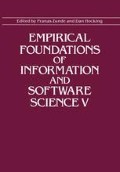Abstract
This paper describes a portion of the OFMspert (Operator Function Model Expert System) research project. OFMspert is an architecture for an intelligent operator’s associate or assistant that can aid the human operator of a complex, dynamic system. Intelligent aiding requires both understanding and control. This paper focuses on the understanding (i.e., intent inferencing) ability of the operator’s associate. Understanding or intent inferencing requires a model of the human operator; the usefulness of an intelligent aid depends directly on the fidelity and completeness of its underlying model. The model chosen for this research is the operator function model (OFM) (Mitchell, 1987). The OFM represents operator functions, subfunctions, tasks, and actions as a heterarchic-hierarchic network of finite state automata, where the arcs in the network are system triggering events. The OFM provides the structure for intent inferencing in that operator functions and subfunctions correspond to likely operator goals and plans. A blackboard system similar to that of HASP (Nii et al., 1982) is proposed as the implementation of intent inferencing function. This system postulates operator intentions based on current system state and attempts to interpret observed operator actions in light of these hypothesized intentions.
The OFMspert system built for this research is tailored for the GT-MSOCC (Georgia Tech Multisatellite Operations Control Center) simulation. The GT-MSOCC OFMspert has been the subject of rigorous validation studies (Jones, 1988) that demonstrate its validity as an intent inferencer.
Access this chapter
Tax calculation will be finalised at checkout
Purchases are for personal use only
Preview
Unable to display preview. Download preview PDF.
References
Chambers, A. G., and Nagel, D. C., 1985, Pilots of the Future: Human or Computer? Communications of the ACM, Vol. 28, No. 11, pp. 1187–1199.
Cohen, A., and Feigenbaum, E. A., 1982, The Handbook of Artificial Intelligence, Addison-Wesley, Reading, Mass.
Jones, P. M., 1988, Constructing and Validating a Model-Based Operator’s Associate for Supervisory Control, Report No. 88–1, Center for Human-Machine Systems Research, School of Industrial and Systems Engineering, Georgia Institute of Technology, Atlanta, GA.
Jones, P. M., and Mitchell, C. M., 1987, Operator Modeling: Conceptual and Methodological Distinctions, Proceedings of the 31st Annual Meeting of the Human Factors Society, Volume 1, pp. 31–35, Santa Monica, CA.
Miller, J. R., Polson, P. G., and Kintsch, W., 1984, Problems of Methodology in Cognitive Science, Method and Tactics in Cognitive Science, Kintsch, W., Miller, J. R., and Poison, P. G., eds., Lawrence Erlbaum Associates, Hillsdale, NJ.
Miller, R. A., 1985, A Systems Approach to Modeling Discrete Control Performance, Advances in Man- Machine Systems Research, Volume 2, Rouse, W. B., ed., pp. 177–248, JAI Press, New York.
Miller, R. A., 1985, A Systems Approach to Modeling Discrete Control Performance, Advances in Man- Machine Systems Research, Volume 2, Rouse, W. B., ed., pp. 177–248, JAI Press, New York.
Mitchell, C. M., 1987, GT-MSOCC: A Research Domain for Modeling Human-Computer Interaction and Aiding Decision Making in Supervisory Control Systems, IEEE Transactions on Systems, Man, and Cybernetics, Vol. SMC-17, pp. 553–572.
Mitchell, C. M., and Forren, M. G., 1987, Multimodal User Input to Supervisory Control Systems: Voice-Augmented Keyboards, IEEE Transactions on Systems, Man, and Cybemetics, Vol. SMC-17, pp. 594–607.
Mitchell, C. M., and Miller, R. A., 1985, A Discrete Control Model of Operator Function: A Methodology for Information Display Design, IEEE Transactions on Systems, Man, and Cybernetics, Vol. SMC-16, pp. 343–357.
Nii, H. P., Feigenbaum, E. A., Anton, J. J., and Rockmore, A. J., 1982, Signal-to-Symbol Transformation: HAS/SLOP Case Study, Heuristic Programming Project, Report No. HPP-82–6, Heuristic Programming Project, Stanford University, Stanford, CA.
Nii, H. P., 1986, Blackboard Systems, AI Magazine, Vol. 7–2, Vol. 7–3.
Rasmussen, J., 1986, Information Processing and Human-Machine Interaction: An Approach to Cognitive Engineering, North-Holland, New York.
Rasmussen, J., 1986, Information Processing and Human-Machine Interaction: An Approach to Cognitive Engineering, North-Holland, New York.
Rubin, K. S., Jones, P. M., and Mitchell, C. M., 1987, OFMspert: Application of a Blackboard Architecture to Infer Operator Intentions in Real Time Decision Making,Report No. 87–6, Center for Human-Machine Systems Research, School of Industrial Systems Engineering, Georgia Institute of Technology, GA. Also IEEE Transactions on Systems, Man, and Cybernetics,toappear.
Schank, R. C., and Abelson, R. P., 1977, Scripts, Plans, Goals, and Understanding, Lawrence Erlbaum Associates, Hillsdale, NJ.
Sheridan, T. B., and Johannsen, G., 1976, Monitoring Behavior and Supervisory Control, Plenum, New York.
Wenger, E., 1987 Artificial Intelligence and Tutoring Systems, Morgan Kaufmann, Los Altos, CA.
Wickens, C. D., 1984, Engineering Psychology and Human Performance, Charles Merrill, Columbus, OH.
Winograd, T., 1972, Understanding Natural Language, Academic Press, New York.
Woods, D. D., 1986, Cognitive Technologies: The Design of Joint Human-Machine Cognitive Systems, The Al Magazine, pp. 86–92.
Author information
Authors and Affiliations
Editor information
Editors and Affiliations
Rights and permissions
Copyright information
© 1990 Plenum Press, New York
About this chapter
Cite this chapter
Jones, P.M., Mitchell, C.M., Rubin, K.S. (1990). Intent Inferencing with a Model-Based Operator’s Associate. In: Zunde, P., Hocking, D. (eds) Empirical Foundations of Information and Software Science V. Springer, Boston, MA. https://doi.org/10.1007/978-1-4684-5862-6_21
Download citation
DOI: https://doi.org/10.1007/978-1-4684-5862-6_21
Publisher Name: Springer, Boston, MA
Print ISBN: 978-1-4684-5864-0
Online ISBN: 978-1-4684-5862-6
eBook Packages: Springer Book Archive

